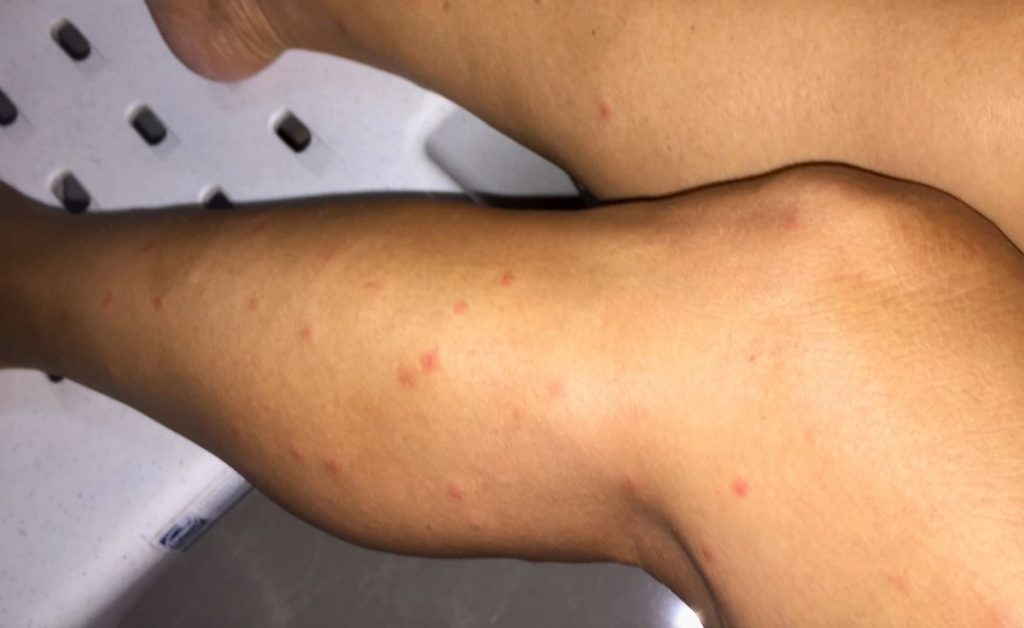What are these bites I keep getting every time I go outside in my yard? The answer is a tiny biting “gnat” commonly known as no-see-ums. Here are some common FAQs and how to get rid of them.
What are these mystery bites I keep getting every time I go outside or in my yard? The answer is a tiny biting “gnat” called Ceratopogonidae, commonly known as “no-see-ums”, or biting midges.
Ceratopogonidae is a family of flies known as no-see-ums or biting midges. Literally getting their name because you can hardly see them, they range in size from 1–3 mm. These pests are a specific kind of gnat. They are tiny and able to fly through many window screens.

Ceratopogonidae have four life stages: egg, larva, pupa, and imago (adult). Most common species in warmer climates will complete their life cycle in two to six weeks. Nectar is consumed by both adult males and females. To obtain protein for egg-laying, most females feed on the blood of vertebrates, including humans. Although tiny, their bites are big, painful, and can result in itchy lesions.
Some species of biting midges are thought to prey on other small insects. Mosquito larvae, in particular, have been studied as common prey for biting midges. If your area is full of mosquitoes, chances are these biting gnats are also present.
What Do No-See-Um Bites Look Like?
No-see-um bites, which are more severe than mosquito bites, start as clusters of small red dots on your skin. Over time, these bites can enlarge into raised welts, up to one to two inches in diameter. Also, note that tender no-see-um welts can linger on your skin for two weeks or more. Some people are more allergic to insect bites, so larger welts may result.

What Are No-See-Ums Attracted To?
What attracts No-See-Ums to humans? Scent! Experts, like those at NC State University, believe it is the odor of carbon dioxide and lactic acid from human skin and breath that attracts no-see-ums. These scents tell the females that a blood meal is nearby, and they will come to feed. Other causes for frequent bites could include genetics, certain bacteria on the skin, or a combination of both. Body odor itself is determined by genetics.
What Can I Do to Stop Getting Bitten?
The best ways to prevent bites are to cover exposed skin – if you’re outside at a time of day when insects are particularly active, such as sunrise or sunset, cover your skin by wearing long sleeves and pants, socks, close-toed shoes when outdoors. Apply insect repellent to exposed skin –Applying bug sprays containing up to 20% DEET is one of the best ways to avoid bug bites in the spring and summer.
How Do I Stop No-See-Um Itching?
If you think you’ve been bitten by no-see-ums, wash the area as soon as possible with warm water and antibacterial soap. You can help relieve the pain and itching with alcohol application on a cotton swab or cotton ball, followed by cold, wet compresses or ice packs. Some natural applications such as lavender essential oil have been known to help with itching.
Where Are No-See-Ums Found?
No-see-ums are generally found in wet, warm climates. Anywhere there is standing or slow-moving waters such as lakes, ponds, marshes, and streams. They can also be found in damp, water-filled tree holes or other water-filled cavities. Some species can even be found in saltwater habitats, or where fresh and saltwater mix.
What Time of Year Do No-See-Ums Come Out?
No-see-ums are warm-weather lovers, so they come out mostly in the summertime, though they can be present year-round in some areas where it’s warm year-round like South Texas or South Florida. They’re most active at dawn and dusk, which are peak biting times.
How Do You Repel No-See-Ums?
Mosquito repellants and natural sprays can deter no-see-ums. Mixtures of essential oils such as lemon eucalyptus, mint, camphor, and lemon have been known to be effective. Once applied, they can provide several hours of protection.
How Do You Get Rid of No-See-Ums In Yard?
The best way to control biting gnats and mosquitoes is to eliminate all standing water in your yard. Maintain cleanliness in your birdbath by dumping old, dirty water and replenishing with clean, fresh water daily. Never leave dog bowls outside filled overnight.
If you have an infestation and can’t even enjoy your backyard, it’s time to bring in the pros! A pest control company will assess your situation and create a regular insecticide program that suits your family, pets and property to get rid of these pesky biting flies. Need help with biting flies and no-see-ums? Contact us NOW or Give us a call today!

